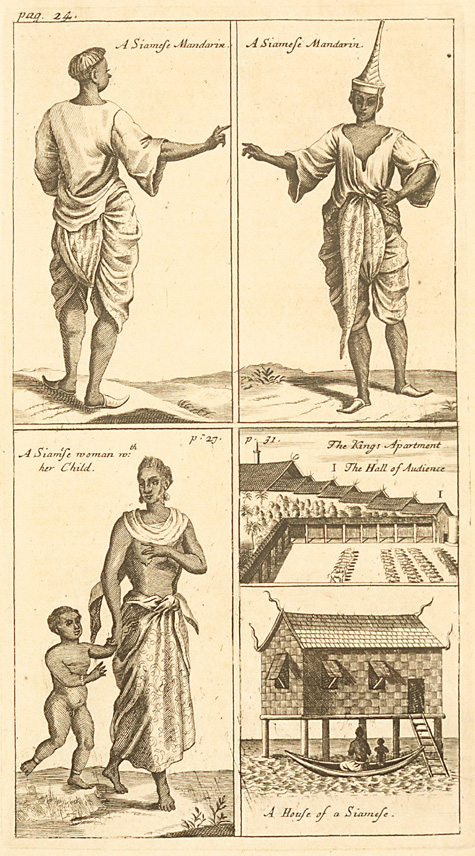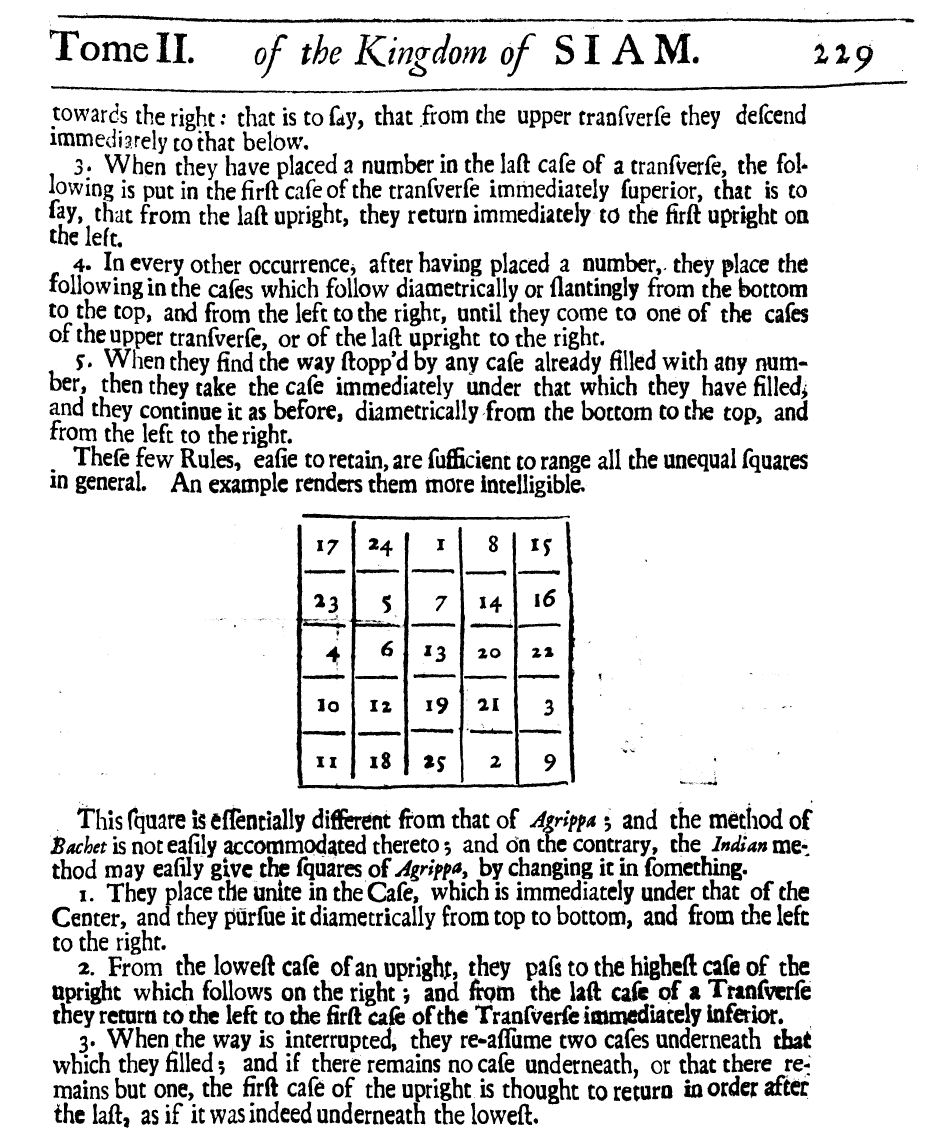Simon de la Loubère on:
[Wikipedia]
[Google]
[Amazon]
 Simon de la Loubère (; 21 April 1642 – 26 March 1729) was a French
Simon de la Loubère (; 21 April 1642 – 26 March 1729) was a French
 La Loubère was elected member of the
La Loubère was elected member of the
Full text in French
o
English translation
*''Traité de l'origine des jeux floraux de Toulouse'' (1715) *''De la Résolution des équations, ou de l'Extraction de leurs racines'', 173
Full text
 Simon de la Loubère (; 21 April 1642 – 26 March 1729) was a French
Simon de la Loubère (; 21 April 1642 – 26 March 1729) was a French diplomat
A diplomat (from grc, δίπλωμα; romanized ''diploma'') is a person appointed by a state or an intergovernmental institution such as the United Nations or the European Union to conduct diplomacy with one or more other states or interna ...
to Siam (Thailand), writer, mathematician and poet. He is credited with bringing back a document which introduced Europe to Indian astronomy
Astronomy has long history in Indian subcontinent stretching from pre-historic to modern times. Some of the earliest roots of Indian astronomy can be dated to the period of Indus Valley civilisation or earlier. Astronomy later developed as a di ...
, the "Siamese method
The Siamese method, or De la Loubère method, is a simple method to construct any size of ''n''-odd magic squares (i.e. number squares in which the sums of all rows, columns and diagonals are identical). The method was brought to France in 1688 by ...
" of making magic square
In recreational mathematics, a square array of numbers, usually positive integers, is called a magic square if the sums of the numbers in each row, each column, and both main diagonals are the same. The 'order' of the magic square is the number ...
s, as well as one of the earliest description of parachute
A parachute is a device used to slow the motion of an object through an atmosphere by creating drag or, in a ram-air parachute, aerodynamic lift. A major application is to support people, for recreation or as a safety device for aviators, w ...
s.
Mission to Siam
Simon de la Loubère led an embassy toSiam
Thailand ( ), historically known as Siam () and officially the Kingdom of Thailand, is a country in Southeast Asia, located at the centre of the Indochinese Peninsula, spanning , with a population of almost 70 million. The country is bo ...
(modern Thailand
Thailand ( ), historically known as Siam () and officially the Kingdom of Thailand, is a country in Southeast Asia, located at the centre of the Indochinese Peninsula, spanning , with a population of almost 70 million. The country is b ...
) in 1687 (the "La Loubère- Céberet mission"). The embassy, composed of five warships, arrived in Bangkok
Bangkok, officially known in Thai as Krung Thep Maha Nakhon and colloquially as Krung Thep, is the capital and most populous city of Thailand. The city occupies in the Chao Phraya River delta in central Thailand and has an estimated populati ...
in October 1687 and was received by Ok-khun Chamnan. La Loubère returned to France on board the ''Gaillard'' on 3 January 1688, accompanied by the Jesuit Guy Tachard
Guy Tachard (; 1651 – 1712), also known as Père Tachard, was a French Jesuit missionary and mathematician of the 17th century, who was sent on two occasions to the Kingdom of Siam by Louis XIV. He was born in Marthon, near Angoulême.
In 1 ...
, and a Siamese embassy led by Ok-khun Chamnan.
Upon his return, La Loubère wrote a description of his travels, as had been requested by Louis XIV
Louis XIV (Louis Dieudonné; 5 September 16381 September 1715), also known as Louis the Great () or the Sun King (), was List of French monarchs, King of France from 14 May 1643 until his death in 1715. His reign of 72 years and 110 days is the Li ...
, published under the title ''Du Royaume de Siam'': "It was by the orders, which I had the honours to receive from the King upon leaving for my voyage to Siam, that I observed in that country, as exactly as possible, all that appeared to be the most singular.
Loubère also brought back with him an obscure manuscript relating to the astronomical traditions of Siam, which he passed on to the famous French-Italian astronomer Jean Dominique Cassini. The Siamese Manuscript, as it is now called, intrigued Cassini enough so that he spent a couple years deciphering its cryptic contents, determining on the way that the document originated in India. His explication of the manuscript appeared in La Loubere's book on the Kingdom of Siam in 1691, which laid the first foundation of European scholarship on Indian astronomy
Astronomy has long history in Indian subcontinent stretching from pre-historic to modern times. Some of the earliest roots of Indian astronomy can be dated to the period of Indus Valley civilisation or earlier. Astronomy later developed as a di ...
.
French career
 La Loubère was elected member of the
La Loubère was elected member of the Académie française
An academy (Attic Greek: Ἀκαδήμεια; Koine Greek Ἀκαδημία) is an institution of secondary or tertiary higher learning (and generally also research or honorary membership). The name traces back to Plato's school of philosop ...
(1693–1729), where he received Seat 16, following the 1691 publication of his book ''Du Royaume de Siam''.
La Loubère was a friend of the German scientist Gottfried Leibniz
Gottfried Wilhelm (von) Leibniz . ( – 14 November 1716) was a German polymath active as a mathematician, philosopher, scientist and diplomat. He is one of the most prominent figures in both the history of philosophy and the history of mathem ...
, and once wrote that he had "no greater joy than (to discuss) philosophy and mathematics" with him (22 January 1681 correspondence).
Magic square
La Loubère brought to France from his Siamese travels a very simple method for creating n-oddmagic squares
In recreational mathematics, a square array of numbers, usually positive integers, is called a magic square if the sums of the numbers in each row, each column, and both main diagonals are the same. The 'order' of the magic square is the number ...
, known as the "Siamese method
The Siamese method, or De la Loubère method, is a simple method to construct any size of ''n''-odd magic squares (i.e. number squares in which the sums of all rows, columns and diagonals are identical). The method was brought to France in 1688 by ...
" or the "La Loubère method", which apparently was initially brought from Surat
Surat is a city in the western Indian state of Gujarat. The word Surat literally means ''face'' in Gujarati and Hindi. Located on the banks of the river Tapti near its confluence with the Arabian Sea, it used to be a large seaport. It is ...
, India, by another Frenchman by the surname of Vincent, who was sailing on the return ship with La Loubère.
Siamese parachute
La Loubère is also famous for making one of the earliest account of aparachute
A parachute is a device used to slow the motion of an object through an atmosphere by creating drag or, in a ram-air parachute, aerodynamic lift. A major application is to support people, for recreation or as a safety device for aviators, w ...
following his embassy to Siam. He reported in his 1691 book that a man would jump from a high place with two large umbrellas to entertain the king of Siam, landing into trees, rooftops, and sometimes rivers.
Works
*''Du Royaume de Siam'', 169Full text in French
o
English translation
*''Traité de l'origine des jeux floraux de Toulouse'' (1715) *''De la Résolution des équations, ou de l'Extraction de leurs racines'', 173
Full text
See also
* France-Thailand relationsReferences
{{DEFAULTSORT:La Loubere, Simon De 1642 births 1729 deaths Ambassadors of France to the Ayutthaya Kingdom Members of the Académie Française Magic squares 18th-century French mathematicians Members of the Académie des Inscriptions et Belles-Lettres 17th-century French diplomats